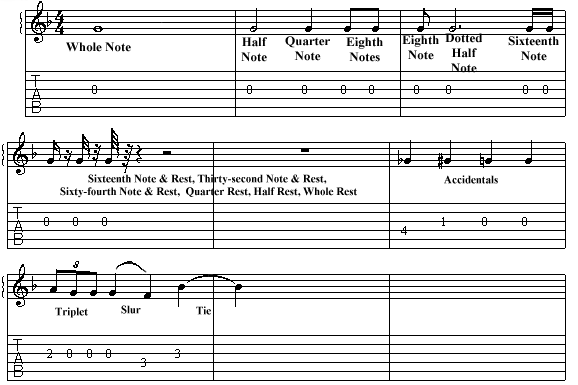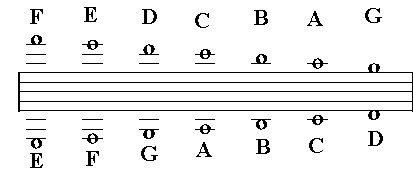Reading Standard Notation
This first installment of reading standard notation will get you familiar with the different notes, rests, and what they stand for. I marked the names of the notes and rests underneath them. The place where it says, "sixteenth note & rest..." refers to the notes and rests for the two measures above the writing. The names go with the notes and rests in the order that they appear (left to right). Notice the really fancy looking G in front of each line. This represents the Treble Clef or the G clef, which is the clef that guitar music is written in. Now notice the 4's stacked upon each other. This is called the Time Signature These numbers are not always 4's. The top number tells you how many beats there are per measure. A measure is the space between bar lines (the vertical lines in the music). The bottom number tells you which note receives 1 beat. When it is 4 the quarter note gets 1 beat. When the number is 8, the eighth note gets 1 beat. When the number is 2, the half note gets 1 beat, and so on. Most of the time in guitar music you will find it to have the stacked 4's which is called Common Time. Sometimes it is signified by a "C" put in place of the numbers. Sometimes you will see a "C" with a vertical line through it. This is called Cut Time. It is the equivalent of stacked 2's.
The Key Signature
The key signature refers to the flats (b) and sharps (#) after the clef and before the time signature. It tells you what key the music is in and what is flattened or sharpened. For example, the Key of G (which is the key of the picture below) has one flat. The flat is on the B line (more on how to read pitches in Part 2). Therefore, every "B" that you come across must be played as a B flat, unless it is acted on by an accidental (more on accidentals below). For more information on the different keys refer to The Circle of Fifths and Determining the Key.
Notes and Rests
| Whole Note | 4 Beats |
| Whole Rest | 4 Beats |
| Half Note | 2 Beats |
| Half Rest | 2 Beats |
| Quarter Note | 1 Beat |
| Quarter Rest | 1 Beat |
| Eighth Note | ½ Beat |
| Eighth Rest | ½ Beat |
| Sixteenth Note | ¼ Beat |
| Sixteenth Rest | ¼ Beat |
| Thirty-second Note | 1/8 Beat |
| Thirty-second Rest | 1/8 Beat |
| Sixty-fourth Note | 1/16 Beat |
| Sixty-fourth Rest | 1/16 Beat |
Now let's look at dotted notes
Dotted notes get a time value of 1½ times the original notes' length. In other words, if you have a dotted half note, it gets 3 beats because 1½ X 2 = 3. If you have a dotted quarter note, it gets 1½ beats because 1½ X 1 = 1½.
Now for slurs and ties
A tie is a curved line that connects 2 notes of the same pitch. The tone is held for the sum of the notes' values. For example, below we tied 2 quarter notes so it is held for 2 beats.
A slur is a curved line that connects notes of different pitches. The first note is plucked, but the second note is not. It is either slid up to using a sliding technique, or it is hammered on or pulled off.
Accidentals Accidentals are sharps (#), flats (b), natural signs (The third sign by the accidentals in the picture below) in front of a note to modify the key signature. If you get a sharp it will raise the pitch ½ step. If you get a flat it will lower the pitch of a note ½ step. If you get a natural sign, it means that you do not sharpen or flatten that note. Accidentals carry through for the whole measure unless they are acted upon by another accidental.
Figure 1

The Notes on the Staff The notes on the staff can be placed either on a line or on a space. The notes ascend starting on the bottom of the staff. The bottom line is E. Any note placed on this line is played E unless there is an accidental or the key signature states otherwise. The space right above it is F. above F is G (on the 2nd line) and so on. The staff ascends alphabetically, not chromatically like the fretboard of the guitar does. The notes may also extend beyond the boundaries of the staff. When this happens, small lines called ledger lines are added.
Here are the tricks to learning the staff.
To Learn the lines (E-G-B-D-F) learn Every Good Boy Does Fine.
To Learn the spaces (F-A-C-E) learn Face, obviously.
Figure 2
